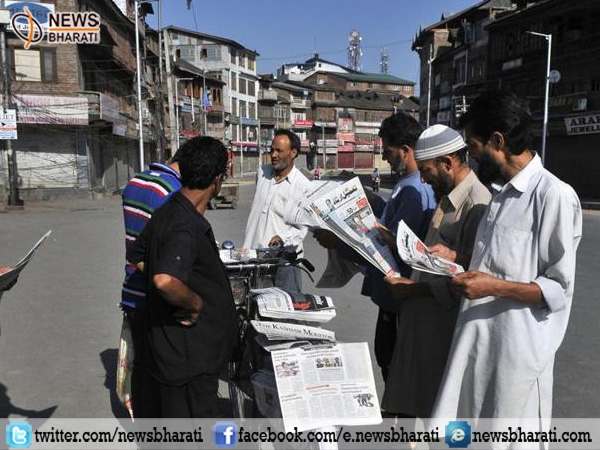Anti national newspapers ruling the roost in J&K need to be curbed
Total Views |
Hindustan Times, a leading national daily of India, carried in its edition of 4, November, a news piece titled, “Stop ads if papers print ‘anti-national’ articles: Centre to Jammu & Kashmir.”

As the title suggests, the news piece pertains to a letter written by the Union Ministry of Home Affairs (MHA) on October 18, 2017 urging the state government to stop advertising in local newspapers that publish anti-national articles.
“It is understood that some newspapers in J&K are publishing highly radicalized content glamorizing terrorists and anti-national elements. This is against the Constitution of India as well as the Constitution of Jammu and Kashmir,” is the content of the letter, which Hindustan Times claims to have seen.
On the very next day, Indian Express, another national daily published in India, quoted a statement from the Government of Jammu and Kashmir saying that it is yet to receive such an order from MHA.
“Maybe they (MHA) have said this, but offices of the information department are closed now for the annual Darbar (Government) move. So I can’t be sure about that,” Muneer-ul-Islam, Director of Information, Kashmir, is quoted to have said by Indian Express.
This statement is quite surprising since a letter written on October, 18, would surely have reached the recipients before the offices started closing for the Durbar move.
It is notable to mention here that despite an official ban in the grant of DAVP advertisement to some Kashmir based newspapers due to their anti-national content and leanings, the state government and important commercial constituents like the Jammu and Kashmir Bank have continued to grant advertisement support to them to the tune of tens of crores of Rupees.
The foregoing is the reason for the MHA to write a letter to the state government. The fact that the state government has declined receipt of the letter gives the indication of an attempt to buy time before responding. Such an attitude comes across as a matter of concern.
The ripples that this news piece has caused in the Kashmir media environment are quite visible. Such newspapers that would be affected have carried the news quite obviously to generate sympathy and a feeling of oppression of free speech by the central government.
Tahir Mohiuddin, a member of Kashmir Editors Guild and editor of a Kashmir based Urdu daily, Chattan, said to Indian Express, “All newspapers are working on professional lines and statements from mainstream, politicians and separatists are being published simultaneously. I think there seems to be some kind of confusion.”
“Three major papers of Kashmir, which include Greater Kashmir, Rising Kashmir and Kashmir Times, have been banned from getting any central government advertisements from the Directorate of Advertising and Visual Publicity (DAVP) for the last eight years. We are already bleeding and now they want us to bleed more by telling the state government to stop state advertisements as well,” said Shujat Bukhari, Editor of Rising Kashmir.
There are more than 600 newspapers and periodicals being published in Jammu and Kashmir. Of these 171 from Kashmir and 204 from Jammu are empanelled. In 1989 only 17 dailies and 16 weeklies were being published in the state.
It is quite evident that the conflict threw up possibilities for an exponential increase of print media in the region and the upsurge opened avenues for anti-national elements to dominate the print space.
While there are many exponents for the so-called unbiased character of journalism in Kashmir, a cursory glance at the newspaper content gives a different picture altogether.
Diktats from terrorists are carried by many newspapers openly, especially in the Urdu press. Muslim columnists and left liberals with an anti-national bias dominate Edit Pages and the instigating diatribe is passed off as the personal views of the writer. In the latest trend, provocative anti-India articles are being passed off with Hindu pseudonyms to give an impression of a wider acceptance of the separatist ideology.
More serious in nature is the regular dose of unrest and violence that dominates the newspapers with larger than life photos of separatists and militants adorning the front page.
Provocative statements on Kashmir by Pakistan gain immediate space while good work by the state or the central government in Kashmir is either ignored or carried in a deep inner page at best.
Pakistan highlights in the international press this daily diatribe against the Indian state carried by newspapers in Kashmir to keep alive the perceptions that there is a mass movement for independence underway in the state.
As the media moves from one sensationalist incident to the other, it fails to address core issues. When, for instance, did the media last highlight the shameless and blatant use of religious places by the terrorists to further their sinful activities? Is it not the responsibility of the media to expose the role being played by the separatists and their paid Maulvis (religious teachers) in facilitating such sacrilegious acts?
Such newspapers should be identified and not only should their advertisement support be stalled, a thorough investigation into the source of income should also be carried out. It is common knowledge that many of these newspapers are being funded by inimical foreign forces through Hawala and money transfers. It is simply not possible for them to be running their huge establishments on the basis of government and local advertisements alone. Simultaneously, there is a need to create more space for a nationalist narrative to counter the propaganda.
Jaibans Singh
(Jaibans Singh is a reputed columnist and author)
